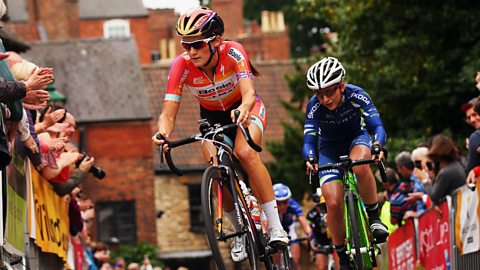Case studies - improving athletic performance
Athlete 1
A 25-year-old elite level long jumper training to improve athletic performance, with a specific goal of being selected by TeamGB for the next athletics World Championships.
Specificity - trainingA planned programme which uses scientific principles to improve performance, skill, game ability and physical fitness. would be focused on explosive strength of the legs by using weights and plyometricExercise which involves exerting maximum force in short intervals of time with the aim to increase muscle power. training. As long jumpers need to be highly flexible, a significant amount of time would be given to increasing flexibility through stretching.
Progressive overload and FITT - training frequency would be approximately six times per week. Training intensity would be increased gradually by increasing the weight lifted and then increasing the target heart rate range in interval sessions. Time can be progressively overloaded by decreasing recovery times in weight training and increasing the numbers of repetitions during plyometric training. Training type can be varied by combining weight, plyometric, interval and flexibility training.
Rest and recovery - the long jumper only has one full rest day each week so training units (sessions) need to be structured to allow for muscle groups to rest and recover. An example of this would be to use a flexibility session the day after a heavy weights and plyometrics day. Likewise the training could be structured so that the athlete works the upper body the day after training the lower body, thus allowing the legs to rest.
Reversibility - the long jumper is training six times per week. Injury and burn-out are avoided by allowing for recovery and providing varied types of training. This should prevent de-adaptation. Injury must be avoided at all costs.

Athlete 2
A 19-year-old road cyclist training to achieve their first professional contract in a European team. The rider is a specialist hill climber.
Specificity - training would be focused on cardiovascular fitness through a process of continuous training with other anaerobic methods used to improve the hill climbing. Training would take place for long periods to prepare the athlete for the full day cycling required by elite road cyclists.
Progressive overload and FITT - training frequency would be approximately six times per week. Training intensity would be increased gradually by increasing the target heart rate range in continuous sessions. Time can be progressively overloaded by increasing the length of sessions and the proportion of the session spent climbing. Training type can be varied by combining continuous, interval and flexibility training.
Rest and recovery - the cyclist only has one full rest day each week so training units (sessions) need to vary in terms of length and intensity. Successive high intensity hill sessions should be avoided. Recovery must be optimised through the use of effective cool downs as well as excellent nutrition between sessions.
Reversibility - the cyclist is training six times per week during in-season training. Attention must be given to ensuring that over-use injuries do not occur by recovering properly from training and by using good nutrition.
